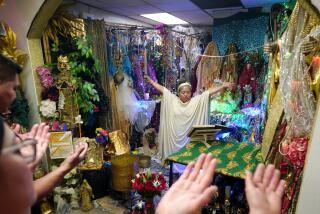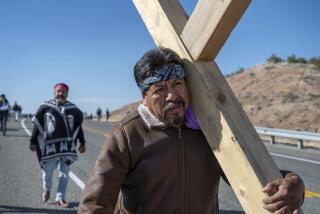Not Your Traditional Charismatic Service
- Share via
SAN CLEMENTE — Four years ago, raucous song made up for the bare walls at St. Michael’s Church, where freewheeling Sunday morning charismatic services were punctuated by pulpit calls to seek salvation and, occasionally, worshipers speaking in tongues.
Today, a more solemn and traditional service prevails--although the drums near the altar manage to keep things lively.
A crucifix and banners with religious themes now adorn the sanctuary. Worship begins with a processional led by church elders wearing vestments--a far cry from the suits and ties previously preferred. Candles flicker and incense fills the air as parishioners celebrate the Eucharist: the transformation of bread and wine into the body and blood of Jesus Christ.
“It’s a radical shift, for sure, from where we were to where we are today,” said Father Kenneth W. Tanner, referring to the ways in which the parish has turned to a more standard form of worship.
“We decided we would just try it for six months. And if the parishioners didn’t like it, we’d stop.
“But we’ve never once looked back.”
Embracing the traditional ways of worship was an unconventional experiment for a charismatic church.
It has, however, been wildly successful. Besides the spiritual rewards--church leaders discovered a richness in the historic ceremonies they once spurned--the change has prompted astonishing growth.
As others have looked on with awe and envy, the movement that began in 1990 with St. Michael’s and three other independent, but loosely connected, charismatic churches in California and Arizona blossomed in mid-1992 into a new denomination: the Charismatic Episcopal Church.
The CEC, which is not affiliated with the 2.5 million-member Episcopal Church, now boasts more than 180 parishes worldwide, including 100 congregations in the United States and 40 in the Philippines. Headquartered in a modest church here on West Marquita, the CEC’s international membership has soared to nearly 40,000--up from a few hundred in the beginning and ranking it as one of the faster-growing new denominations, experts say.
“It’s quite an extraordinary thing,” said Bishop John W. Howe of the Episcopal Diocese of Central Florida. “They’ve seen an incredible amount of growth.”
At first glance, adopting the traditional worship of the ancient church may seem contradictory for charismatics, who shun rites and rituals in favor of unstructured worship where the atmosphere is often euphoric. Occasionally, parishioners moved by the Holy Spirit may speak in tongues or lay on healing hands.
In contrast, liturgical worship, such as in the Roman Catholic Church, is more formal. Orchestrated on Bible readings, fixed prayers and hymns, the service centers on the celebration of the Eucharist.
Robert Webber, a theology professor at Wheaton College in Illinois, believes traditionalists and charismatics can appreciate each other’s distinct forms of worship without betraying their own roots.
“The church in the 20th century seems to be following the curvature of culture more so now than ever before,” Webber said. “Churches are making those accommodations in different ways.”
Some congregations within the Episcopal Church, for example, borrow from the charismatics and say the CEC is a welcome addition.
“The charismatic movement within Christendom is bringing a great deal of energy to the expression of faith,” said Robert Williams, communications director for the Los Angeles Diocese of the Episcopal Church, which includes Orange County.
The CEC’s membership in the United States is mostly white, but African Americans, Latinos and Asians are also present. The denomination is made up chiefly of charismatic Pentecostals, although former Episcopalians, Lutherans and others have joined, Tanner said.
Archbishop Randolph Adler, who leads Sunday worship at St. Michael’s, said the changes harken back to the early 1990s, when he and other church elders began studying their religious roots. Their reflection on the ancient liturgy of Christian worship made them wonder whether they weren’t missing out on something that would enrich the charismatic movement.
“We were not turning our backs on what we were,” Adler said. “We were trying to improve on it.”
A special meeting was called and parishioners agreed with Adler’s suggestions that St. Michael’s experiment with the changes for a few months. Not everyone was thrilled at the time.
Chris Carpenter of San Clemente was dubious at first, but has no regrets now. She had joined the charismatic church more than 10 years ago, in part because it was so different from her Catholic Church upbringing.
“At first, it was kind of scary; I was nervous about it,” the 38-year-old homemaker said. “But it brought a discipline, a consistency that wasn’t there before. I surprised myself, but it’s been a real joy.”
The changes are subtle but significant. Parishioners make the sign of the cross upon entering church and during Gospel readings. Vestments, incense, candles, crosses and crucifixes--previously considered unnecessary--are now present.
Others changes go to the heart of the service. In the past, the Eucharist was celebrated just a few times a year. Now, it is celebrated at each service.
Sermons are also different.
Before, the conversations from the pulpit were driven by the pastor’s personality and his choice of topics. Today, sermons are guided by the Scriptures, and in the process, the parish as a whole eventually reads through the entire Bible.
Grace Barnes, 41, a Capistrano Beach librarian, said she is pleased to belong to a congregation that is not afraid to experiment. She turned to the church 20 years ago after being a non-practicing Christian.
“I’m extremely happy, I feel like God is blessing this,” Barnes said. “I believe God is calling churches to unite, like we’re doing.”
Father Tanner said St. Michael’s lost only a few members to the changes, including several who were drawn back to the Roman Catholic faith by the transformation.
The church’s search for its history also resulted in new outreach programs to the poor. St. Michael’s Society hands out food staples to about 150 adults each Wednesday night and assists poor families with lodging, gas money to get to work, and other services.
“Unfortunately, that’s something we didn’t do before,” Tanner said. “Then we realized that helping the poor is an important part of our background.”
The growth of the CEC took off when a prominent magazine in the Christian community profiled the transformation at St. Michael’s.
Suddenly, the phone started ringing and wouldn’t stop. Churches throughout the country and around the world were making similar changes. These are the churches that are becoming part of the CEC’s growing conglomeration.
“It was shocking,” Adler recalled. “We thought we were all alone with this. And there were all these other churches doing the same thing. I guess God chooses little, obscure ways.”
The CEC is ruled by a handful of archbishops who watch over regions and bishops who oversee dioceses. All remain linked by newsletter and the Internet. Church officials say they operate on a shoestring budget that relies on the donations of parishioners.
The CEC takes a hard line on many social issues. It is staunchly against abortion and opposes same-sex marriages. Homosexuals are welcome, but only if they are celibate, Tanner said. While women are active in the church, they cannot be ordained priests.
Church officials from other denominations are looking on with a sense of wonder and, in some cases, concern.
Bishop Howe of the Episcopal Diocese of Central Florida said he supports the CEC but believes the hierarchy gives too much power to bishops and that the CEC is too eager to accept defecting Episcopal Church leaders who have had trouble or fallings-out elsewhere.
Tanner responded that all church elders go through a careful screening process and that CEC congregants play a critical role in running the church.
In the future, church officials see their experiment influencing many other denominations and making worship more meaningful.
“That’s what our revelation was that we had years ago,” said Archbishop Adler, referring to the melding of charismatic worship and ancient liturgy.
“Why can’t we have it all?”
More to Read
Sign up for Essential California
The most important California stories and recommendations in your inbox every morning.
You may occasionally receive promotional content from the Los Angeles Times.














